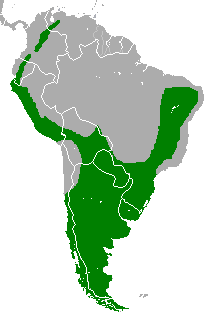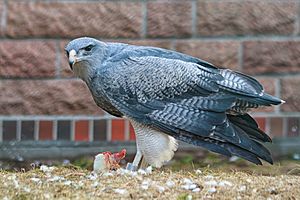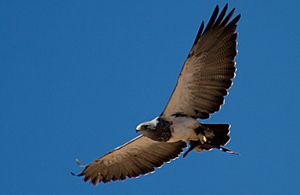Black-chested buzzard-eagle facts for kids
The black-chested buzzard-eagle (Geranoaetus melanoleucus) is a large bird of prey that belongs to the hawk and eagle family, called Accipitridae. This impressive bird lives in open areas across South America. You might also hear it called the black buzzard-eagle, gray buzzard-eagle, or even the Chilean blue eagle.
Quick facts for kids Black-chested buzzard-eagle |
|
|---|---|
 |
|
| Adult male G. m. australis showing the contrasting underside plumage. In the nominate subspecies, the contrast is even stronger due to the pure white belly. Note short grey-tipped tail. |
|
| Conservation status | |
| Scientific classification | |
| Genus: |
Geranoaetus
|
| Species: |
melanoleucus
|
 |
|
| Range of Geranoaetus melanoleucus | |
| Synonyms | |
|
Buteo fuscescens (Vieillot, 1819) |
|
Contents
What Does It Look Like?
This bird is a very large, eagle-like "buzzard" (which Americans call a "hawk"). It can be 62 to 76 cm (24 to 30 in) long, and its wings can spread from 149 to 200 cm (4 ft 11 in to 6 ft 7 in) wide. Males usually weigh around 2.13 kg (4.7 lb), while females are heavier, about 2.75 kg (6.1 lb).
The black-chested buzzard-eagle looks very strong and powerful. It has long, wide wings and a short, black tail with grey tips. When it sits, its wings almost completely cover its tail, making it look like it has no tail at all!
Adult birds have a white belly, sometimes with thin black stripes. Their upper body is dark grey, sometimes looking black, brownish, or bluish. The feathers on their neck and lower chest are a bit longer. They also have a cool ash-grey and white pattern on their wings that you can see easily when they fly.
Female birds are larger than males. They also have a reddish-cinnamon color on the underside of their wing feathers.
Young Birds
Young black-chested buzzard-eagles look different from adults. Their upper parts are deep brown, almost black, and they don't have the light wing patch. Their underside is white or light tan with dark stripes on the chest and dark bars on the belly. They don't get their full adult colors until they are 4 or 5 years old.
Sounds They Make
These birds don't make a lot of noise. They usually call out when they are flying or near their nest. Some of their calls sound like a wild human laugh, while others are a whistle, like a curlew bird. Sometimes, flying birds make a high-pitched "kukukukuku" sound.
When you see a black-chested buzzard-eagle flying, it's easy to spot because of its short, wedge-shaped tail and long, broad wings. If it's an adult, you can usually see its white underside with a dark chest band and tail.
Scientific Name and Family
The scientific name, Geranoaetus melanoleucus, comes from Ancient Greek. Geranoaetus means "crane-eagle," because of its grey upper wings and loud calls. Melanoleucus means "black-and-white," referring to its contrasting colors when seen from below.
This bird is closely related to the Buteo hawks. Some scientists even put it in the Buteo group. However, many still use its own unique genus name, Geranoaetus. Even though it's called an "eagle," it's not a "true eagle" like the Aquila eagles. It's the largest type of hawk in its group.
Different Types of Black-Chested Buzzard-Eagles
There are two main types, or subspecies, of the black-chested buzzard-eagle:
- Eastern black-chested buzzard-eagle (Geranoaetus melanoleucus melanoleucus): This type lives in southeastern South America, including parts of Brazil, Paraguay, Uruguay, and northeastern Argentina. It is larger and has a plain white underside.
- Western black-chested buzzard-eagle (Geranoaetus melanoleucus australis): This type lives in the Andes mountains, from Venezuela down through Colombia, Ecuador, Peru, Bolivia, Chile, and western Argentina to Tierra del Fuego. It is a bit smaller and has fine dark stripes on its white underside.
Where It Lives and What It Eats
The black-chested buzzard-eagle lives in mountains or hilly areas. It likes places with not too many trees, or with shrubs and forests. It often spends a lot of time soaring high in the sky, riding warm air currents. This helps it look for food. It usually lives between 5,000 feet (1,500 m) and 15,000 feet (4,600 m) above sea level.
These birds are most active in the mid-morning and afternoon. They look for places with good air currents for soaring, like slopes facing north or west. They seem to enjoy flying and playing in the air, sometimes alone or in pairs.
What's on the Menu?
This bird is a carnivore, meaning it eats meat. Its main food is medium-sized mammals. European rabbits, which were brought to South America, have become a very important food source for them. This is helpful to farmers because rabbits can be a big problem for crops. Other animals they eat include Common degus, viscachas, and other rodents.
Sometimes, they also eat smaller meat-eating animals like skunks and foxes. They might also catch birds, such as small songbirds, owls, or larger birds like guans and tinamous. If they need to, they will also eat large lizards, insects, or even dead animals (carrion). The black-chested buzzard-eagle is at the top of the food chain in its habitat, especially since it's the only large eagle found outside of forests in the Andes.
Nesting Habits
Black-chested buzzard-eagles build their nests in tall trees or on rocky cliffs. If there aren't any high places, they might even nest in bushes or on the ground. Their nest is a big pile of sticks, about 85 centimetres (33 in) wide. They might use an old nest or build a new one.
The male and female birds perform special flights to attract each other. The female usually lays 2 eggs, but sometimes 1 or 3. The eggs hatch after about a month. The baby birds are likely covered in soft white down. While usually not aggressive, these birds will fiercely attack humans if they feel their nest or babies are in danger.
Conservation Status
The black-chested buzzard-eagle is considered a species of "Least Concern" by the IUCN. This means it's not currently in danger of disappearing. While its numbers are decreasing in some areas, like parts of Brazil and Argentina, it can actually benefit from deforestation in some ways. For example, it has moved into areas where forests like the Mata Atlântica have been cleared. However, in Argentina, some declines have been linked to harmful substances used by sheep farmers to control pests.
Gallery
Images for kids
See also
 In Spanish: Águila mora para niños
In Spanish: Águila mora para niños









